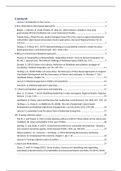Content
Lecture 1 Introducton to the course.................................................................................................1
Actve citzenship & place-based approaches........................................................................................3
Bakker, J., Denters, B., Oude Vrielink, M., Klok, P.J. (2012) Citzenss Initatvese How local
governments fll their facilitatve role. Local Government Studies....................................................3
Fabrizio Barca, Philip McCann, Andrés Rodriguez-Pose (2012) The case for regional development
interventone place-based versus place-neutral approaches, Journal of Regional Science 52 (1),
134-152..............................................................................................................................................5
George, G. & Reed, M.G. (2017) Operatonalising just sustainabilitye towards a model for place-
based governance, Local Environment, 22e9, 1105-1123..................................................................7
Politcs of connectvity & Relatonal approach.......................................................................................9
Massey, D. Geographies of Responsibility, Geografska Annaler. Series B, Human Geography Vol.
86, No. 1, Special Issuee The Politcal Challenge of Relatonal Space (2004), pp. 5-18.......................9
Escobar, E. (2001) Culture sits in placese Refecton on Globalism and subaltern strategies of
Localizaton. Politcal Geography, Vol. 20e 139-174.........................................................................11
Horlings, L.G. (2018) Politcs of Connectvitye The Relevance of Place-Based Approaches to Support
Sustainable Development and the Governance of Nature and Landscape, Ine Marsden, T. (Ed.)
Handbook Nature, chapter 16.........................................................................................................13
Lecture 2e Relatonal approach & Politcs of Connectvity...............................................................16
Tutorial 1e A relatonal approach in planning...................................................................................17
ITe Citzens partcipaton, governance and leadership.........................................................................19
Beer, A., & Clower, T. (2013) Mobilizing leadership in cites and regions. Regional Studies, Regional
Science, 1e1, pp. 5-20.......................................................................................................................19
Hambleton, R. Power, place and the New Civic Leadership, Local Economy, Vol. 30(2) 167– 172.. 22
Horlings, L. G., Roep, D., & Wellbrock, W. (2018). The role of leadership in place-based
development and building insttutonal arrangements. Local Economy 33(3), 245-268..................24
Lecture 3e Leadership in and for places View of leadership throug tme.........................................27
WEe Framing collectve acton..............................................................................................................28
Pacchi, C. and Pasqui, G. (2015) Urban planning without confictss Observatons on the nature and
conditons for urban contestaton in the case of Milan...................................................................28
Seyfang, G. and Smith, A. (2007). Grassroots innovatons for sustainable developmente Towards a
new research and policy agenda. Environmental Politcs 16(4), pp. 584-603..................................29
Gibson-Graham, J.K., Cameron J., and Healy, S. (2013) Reframing the Economy, Reframing
Ourselves. Ine bringing back the economy, chapter 1, pp. 1-16.......................................................32
Lecture 4e Framing collectve acton & confict................................................................................34
Ie Values and Motvatons....................................................................................................................37
Stuart, C. and F.N. Knapp (2015). Sense of placee A process for identfying and negotatng
potentally contested visions of sustainability. Environmental Science and Policy 53 (2015), 38-46.
.........................................................................................................................................................37
, OsBrien, K., & Sygna, L. (2013). Responding to climate changee The three spheres of
transformaton.................................................................................................................................40
Horlings, L.G. (2015). Values in placee A value-oriented approach toward sustainable placeshaping.
Regional Studies, Regional Science, 2 (1)e 256–273.........................................................................42
Jans, L., Bouman, T. and Fielding, K. (2018) A Part of the Energy “In Crowd” Changing Peopless
Energy Behavior via Group-Based Approaches................................................................................45
THEYe Responsive governance, coalitons and identty politcs............................................................47
Lieven de Cauter (2004). The rise of the generic city, ine Lieven de Cauter, The capsular civilizatone
Rotterdame NIA Publishers, pp. 11-26..............................................................................................47
Van Assche, K., and Lo, (2011) M.C. Planning, preservaton and place brandinge A tale of sharing
assets and narratves, Place Branding and Public Diplomacy, 7(2), 116–126...................................49
Oliveira, E. (2015) Place branding as a strategic spatal planning instrument. Place Branding and
Public Diplomacy, 11(1)e 18-33........................................................................................................50
,Lecture 1 Introduction to the course
Wat is the course aboute
I) SPATIAL TRANSFORMATION
II) SOCIETY ENGAGING IN PLACES & PLACE-SHAPING
III) ENABLING, RESPONSIVE PLANNING and ‘CITIZENLEDs PLANNINGs
A more sustainable future is needed because of climate change etc.
This requires a transformaton from the inside out. So a focus on beliefs, values, the inner
dimension to change systems and structures.
So central queston of the course ise
Why and how do citiznn npataaay znnanz in nhapinn paaczn and what in an
znabainn roaz of paanninn?
Why is there a rise of actvz citiznnhips
Rewed interest in place, community and local identty (sense of place etc.) reacton to
globalisaton.
Need for transformaton (sustainable)
Collaboratve governance bottom-up movement
More experts citzens
Social economy trend (sharing economy for example)
Erosion of welfare state and public services
Szaf-novzrnancz of Citiznn initatvzne Collectve actvites by citzens aimed at providing local ‘public
goods or servicess(e.g. regarding the liveability and safety) in their street, neighbourhood or town, in
which citzens decide themselves both about the aims and means of their project and in which local
authorites have a supportng or facilitatng role”
Grannrootn innovatonne
Bottom up solutons for sustainability
Solutons that respond to the local situaton and the interests and values of the communites
involved
Community led
Neglected by policy, because it is not a start-up thing
Sharinn citzne
Beyond nharinn zconomy seeing cites as sharing enttes with shared public services
Not only ‘right to the citys but also right to remake them
Redefning what cites can become taking responsibility for the future
Seen as npacz of ponnibiaity
1
, 2





